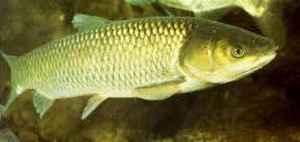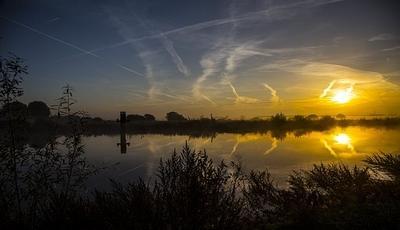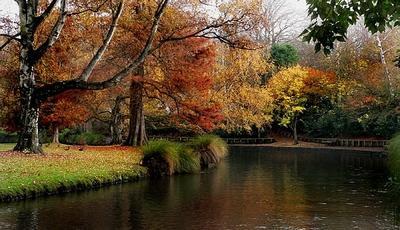Grass Carp a incredible species
Habitat and Behavior of this species: Understanding the Ecology of an Herbivorous Fish
If you're interested in learning more about the White amur, an herbivorous fish that plays an important ecological role in freshwater habitats, this article is for you. In this article, we'll delve into the habitat and behavior of the Chinese carp, providing a comprehensive overview of its ecology and natural history.
Whether you're a fisherman, a biologist, or simply curious about the natural world, this article will provide valuable insights into the fascinating world of the carp. So, let's dive in and explore the ecology of this intriguing species!
This carp, also known as white amur, is a freshwater fish species native to the rivers of eastern Asia, particularly China. They are a member of the Cyprinidae family, which includes carp, minnows, and other similar species.
This species are popularly known for their herbivorous diet, as they primarily feed on aquatic vegetation. The carp is a popular fish species for aquaculture, as it is easy to raise and can quickly grow to market size. It is also often used for biological control of aquatic weeds, as it can effectively manage the growth of invasive vegetation in freshwater ecosystems.
They have become an introduced species in many parts of the world, including North America and Europe, where they have been introduced for aquaculture purposes or as a biological control agent for aquatic weeds. However, their introduction has caused some ecological concerns, as they can potentially outcompete native fish species and alter the balance of freshwater ecosystems.
Overall, the carp is an interesting and important fish species, both in terms of its ecological role and its economic significance in aquaculture.
Whether you're a fisherman, a biologist, or simply curious about the natural world, this article will provide valuable insights into the fascinating world of the carp. So, let's dive in and explore the ecology of this intriguing species!
This carp, also known as white amur, is a freshwater fish species native to the rivers of eastern Asia, particularly China. They are a member of the Cyprinidae family, which includes carp, minnows, and other similar species.
This species are popularly known for their herbivorous diet, as they primarily feed on aquatic vegetation. The carp is a popular fish species for aquaculture, as it is easy to raise and can quickly grow to market size. It is also often used for biological control of aquatic weeds, as it can effectively manage the growth of invasive vegetation in freshwater ecosystems.
They have become an introduced species in many parts of the world, including North America and Europe, where they have been introduced for aquaculture purposes or as a biological control agent for aquatic weeds. However, their introduction has caused some ecological concerns, as they can potentially outcompete native fish species and alter the balance of freshwater ecosystems.
Overall, the carp is an interesting and important fish species, both in terms of its ecological role and its economic significance in aquaculture.
Quick access to the various articles
Fish Description Sheet

Scientific name: Ctenopharyngodon idella
Common names: White amur
Size: this species can grow up to 4 feet in length and can weigh up to 100 pounds, although most individuals are much smaller.
Appearance: this carp have a sleek, torpedo-shaped body with large, silvery scales. They have a relatively small head with a blunt snout and a wide mouth that is adapted for grazing on aquatic plants. They have no teeth in their mouth, but they have a set of pharyngeal teeth in their throat that are used for crushing and grinding plant material. They have a single dorsal fin, which is set far back on their body, and a deeply forked tail.
Conservation status: This weed eater are not currently listed as threatened or endangered, although they are considered a species of concern in some areas due to their potential impact on native aquatic plant communities.
In summary, this species, herbivorous fish with a unique set of adaptations for feeding on aquatic plants. They play an important ecological role in freshwater habitats and are highly valued for their ability to control invasive weeds. Understanding the ecology and behavior of this species is important for managing and conserving freshwater ecosystems.
Common names: White amur
Size: this species can grow up to 4 feet in length and can weigh up to 100 pounds, although most individuals are much smaller.
Appearance: this carp have a sleek, torpedo-shaped body with large, silvery scales. They have a relatively small head with a blunt snout and a wide mouth that is adapted for grazing on aquatic plants. They have no teeth in their mouth, but they have a set of pharyngeal teeth in their throat that are used for crushing and grinding plant material. They have a single dorsal fin, which is set far back on their body, and a deeply forked tail.
Conservation status: This weed eater are not currently listed as threatened or endangered, although they are considered a species of concern in some areas due to their potential impact on native aquatic plant communities.
In summary, this species, herbivorous fish with a unique set of adaptations for feeding on aquatic plants. They play an important ecological role in freshwater habitats and are highly valued for their ability to control invasive weeds. Understanding the ecology and behavior of this species is important for managing and conserving freshwater ecosystems.
Their Habitat

The Perfect Environment for Healthy Fish
Carp are a popular species of fish that are prized for their ability to control aquatic weeds and improve water quality. These fish are native to Asia but have been introduced to various parts of the world, including the United States, where they are commonly used in fisheries and aquaculture operations.
To ensure the health and well-being of carp, it is important to provide them with the proper habitat. In this article, we will explore the ideal habitat and the factors that contribute to their thriving in such an environment.
- Water Quality
The quality of water is a critical factor in the survival and health of carp. These fish require clear, clean water with high oxygen levels. Water that is murky or polluted can lead to stress and illness, and even death in severe cases. This species are also sensitive to changes in pH, temperature, and salinity, so maintaining a stable water environment is crucial.
- Vegetation
This carp are primarily herbivorous, meaning they feed on aquatic plants. A healthy herbivorous carp habitat should have an abundance of vegetation for the fish to graze on. Providing a diverse array of plants such as duckweed, water hyacinth, and water lettuce, not only provide nutrition for the fish but also helps to maintain water quality by filtering out nutrients and reducing algae growth.
- Shelter
Grass eater are susceptible to predation, especially when they are young. Providing ample shelter in the form of submerged logs, rocks, and artificial structures can help protect them from predators. Additionally, these structures provide areas for the fish to rest and hide, reducing their stress levels.
- Water Depth
This carp prefer water that is at least three feet deep. Shallow water can lead to overheating, which can be dangerous to the fish. Moreover, deeper water provides better insulation against temperature fluctuations, protecting the fish from sudden temperature changes.
Conclusion
Creating the ideal habitat requires attention to detail and a commitment to providing a healthy environment. Factors such as water quality, vegetation, shelter, and water depth all play a crucial role in the survival and well-being of these fish. By taking the necessary steps to maintain an ideal habitat, you can ensure that your grass eater thrive and provide the benefits they are known for.
Carp are a popular species of fish that are prized for their ability to control aquatic weeds and improve water quality. These fish are native to Asia but have been introduced to various parts of the world, including the United States, where they are commonly used in fisheries and aquaculture operations.
To ensure the health and well-being of carp, it is important to provide them with the proper habitat. In this article, we will explore the ideal habitat and the factors that contribute to their thriving in such an environment.
- Water Quality
The quality of water is a critical factor in the survival and health of carp. These fish require clear, clean water with high oxygen levels. Water that is murky or polluted can lead to stress and illness, and even death in severe cases. This species are also sensitive to changes in pH, temperature, and salinity, so maintaining a stable water environment is crucial.
- Vegetation
This carp are primarily herbivorous, meaning they feed on aquatic plants. A healthy herbivorous carp habitat should have an abundance of vegetation for the fish to graze on. Providing a diverse array of plants such as duckweed, water hyacinth, and water lettuce, not only provide nutrition for the fish but also helps to maintain water quality by filtering out nutrients and reducing algae growth.
- Shelter
Grass eater are susceptible to predation, especially when they are young. Providing ample shelter in the form of submerged logs, rocks, and artificial structures can help protect them from predators. Additionally, these structures provide areas for the fish to rest and hide, reducing their stress levels.
- Water Depth
This carp prefer water that is at least three feet deep. Shallow water can lead to overheating, which can be dangerous to the fish. Moreover, deeper water provides better insulation against temperature fluctuations, protecting the fish from sudden temperature changes.
Conclusion
Creating the ideal habitat requires attention to detail and a commitment to providing a healthy environment. Factors such as water quality, vegetation, shelter, and water depth all play a crucial role in the survival and well-being of these fish. By taking the necessary steps to maintain an ideal habitat, you can ensure that your grass eater thrive and provide the benefits they are known for.
Carp behavior

Introduction
Also known as white amur, are herbivorous fish commonly used for aquatic weed control. These fish have unique behaviors that are important to understand for effective management of their populations. In this article, we will explore the behavior of carp in detail, including their feeding habits, reproductive behavior, and movement patterns.
Feeding Habits
This grass eater are primarily herbivorous and feed on aquatic plants. They have a strong preference for submerged plants, but they will also eat emergent and floating plants. Carp can consume up to three times their own body weight in vegetation each day, making them a powerful tool for controlling weed growth in lakes, ponds, and other bodies of water.
Reproductive Behavior
This species reach sexual maturity between 2-5 years of age, depending on the water temperature and availability of food. Females lay their eggs in shallow water, and males fertilize them externally. They are prolific breeders, with a single female capable of producing up to 1 million eggs per year. However, successful reproduction can be hindered by factors such as water temperature, water quality, and the availability of spawning habitat.
Movement Patterns
Carp are known for their long-distance movement patterns. They are capable of traveling up to 60 miles in a year, and they can migrate upstream or downstream in rivers and streams. This species are also capable of jumping over barriers such as dams and weirs, which can complicate efforts to control their populations.
Controlling of Populations
Effective management of carp populations requires a comprehensive understanding of their behavior. One approach is to stock ponds and lakes with this species to control weed growth, but this approach can be costly and may not be effective in the long term. Alternatively, barriers such as screens or nets can be used to prevent carp from entering sensitive areas, and physical removal methods such as electrofishing can be used to reduce their populations.
Conclusion
Understanding the behavior of grass eater is essential for effective management of their populations. By understanding their feeding habits, reproductive behavior, and movement patterns, managers can develop strategies for controlling these fish in lakes, ponds, and other aquatic habitats. With the right management approach, carp can be a valuable tool for controlling weed growth and maintaining healthy aquatic ecosystems.
Also known as white amur, are herbivorous fish commonly used for aquatic weed control. These fish have unique behaviors that are important to understand for effective management of their populations. In this article, we will explore the behavior of carp in detail, including their feeding habits, reproductive behavior, and movement patterns.
Feeding Habits
This grass eater are primarily herbivorous and feed on aquatic plants. They have a strong preference for submerged plants, but they will also eat emergent and floating plants. Carp can consume up to three times their own body weight in vegetation each day, making them a powerful tool for controlling weed growth in lakes, ponds, and other bodies of water.
Reproductive Behavior
This species reach sexual maturity between 2-5 years of age, depending on the water temperature and availability of food. Females lay their eggs in shallow water, and males fertilize them externally. They are prolific breeders, with a single female capable of producing up to 1 million eggs per year. However, successful reproduction can be hindered by factors such as water temperature, water quality, and the availability of spawning habitat.
Movement Patterns
Carp are known for their long-distance movement patterns. They are capable of traveling up to 60 miles in a year, and they can migrate upstream or downstream in rivers and streams. This species are also capable of jumping over barriers such as dams and weirs, which can complicate efforts to control their populations.
Controlling of Populations
Effective management of carp populations requires a comprehensive understanding of their behavior. One approach is to stock ponds and lakes with this species to control weed growth, but this approach can be costly and may not be effective in the long term. Alternatively, barriers such as screens or nets can be used to prevent carp from entering sensitive areas, and physical removal methods such as electrofishing can be used to reduce their populations.
Conclusion
Understanding the behavior of grass eater is essential for effective management of their populations. By understanding their feeding habits, reproductive behavior, and movement patterns, managers can develop strategies for controlling these fish in lakes, ponds, and other aquatic habitats. With the right management approach, carp can be a valuable tool for controlling weed growth and maintaining healthy aquatic ecosystems.
©2016/2024 - carpe-amour.com /